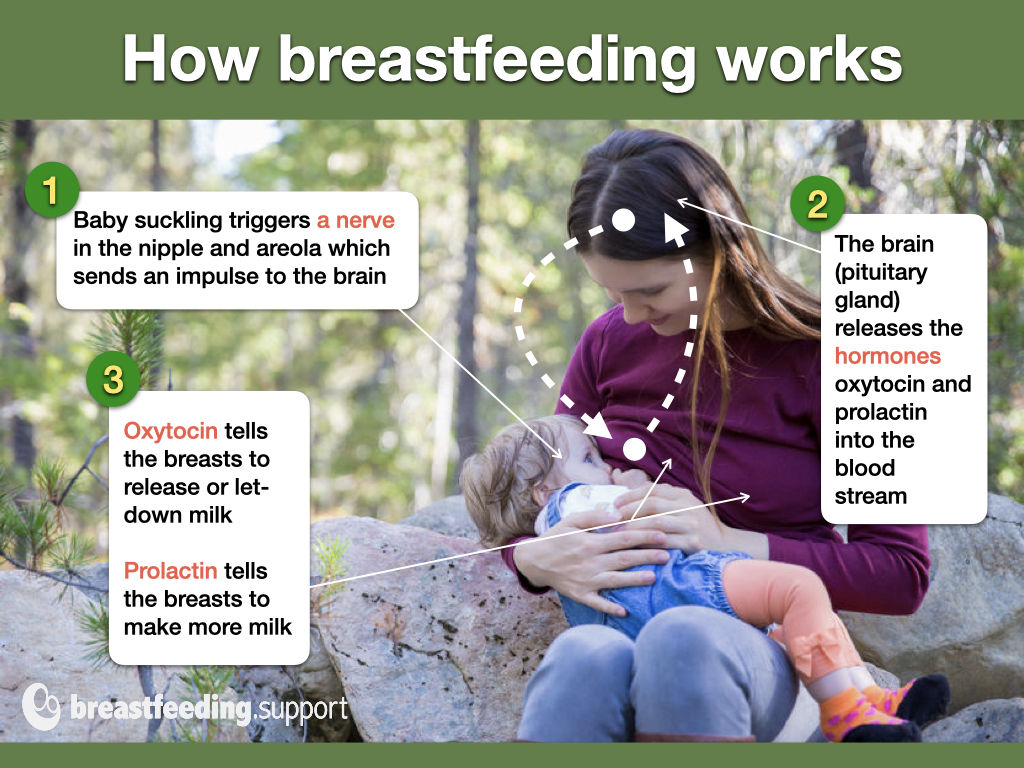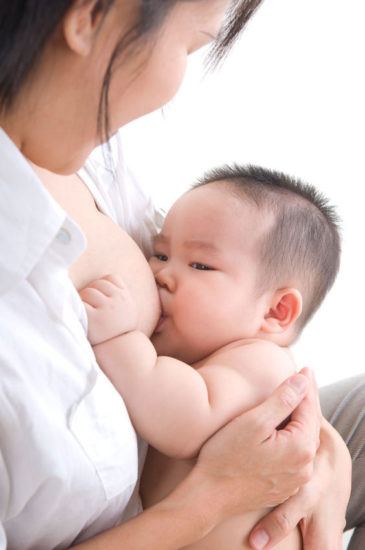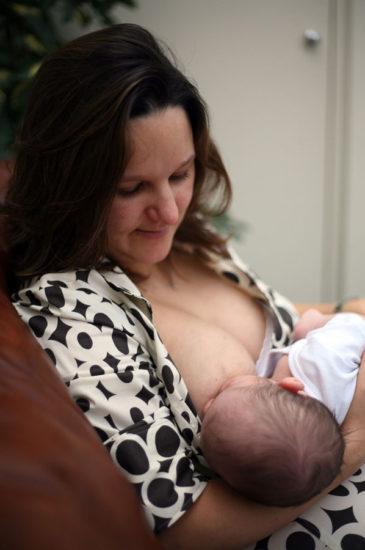Should a baby have one breast per feed or both sides? This article looks at how breastfeeding works to help understand whether a baby needs one breast or two per feed, how often a baby might want to breastfeed and what to do if a baby needs more milk.
How breastfeeding works
When a baby breastfeeds, hormones are released from the mother’s brain to tell the breasts to make and release milk to her baby (see graphic). The more often a baby breastfeeds and drinks the available milk, the faster the breasts will make more milk to replace it.
Breasts make different amounts of milk
How much breast milk a breast can hold or store varies from mother to mother and even from breast to breast within the same mother. It could be anything from 30ml (1oz) or less to 120ml (4oz) or more. How much breast milk a breast can store is known as the storage capacity. A mother with a small storage capacity can make just as much milk each day as one with a large storage capacity but she will need to feed her baby more often.
Size doesn’t matter
It’s not possible to tell how much breast milk a mother’s breasts can hold or store by looking at purely the size of the breasts because the amount of fatty tissue will control the bra/cup size. It is the amount of milk making tissue (glandular tissue) within the breast that controls the amount of milk stored between feeds. So how can a mother know what her storage capacity is and whether her baby needs one breast or two per feed?
One breast or two per feed?
Let your baby decide! The best person to tell you how many breasts to have at each feed, and how often he needs to feed, is your baby. As different mothers store different amounts of milk there can’t be a single rule for all babies. For example, the baby of a mother who can store 60ml in each breast might want both breasts per feed most of the time. However the baby of a mother who stores 120ml or more in each breast might only want one breast per feed most of the time. You don’t need to know how much milk is stored in your breasts so long as your baby is:
- fed on demand—offered a breastfeed whenever he wants one
- allowed to finish the first breast of his own accord before offering the second side (or third or fourth)
- has plenty of dirty nappies and is gaining weight appropriately and thriving
When breastfeeding is going well, a healthy baby will let you know when he is hungry, how many breasts he needs and how often. A baby interested in milk from both breasts will let go of the first breast and happily take the second side when it is offered. A baby who is contented with one breast will either fall asleep on the first breast or refuse the second side when it is offered. The exception to this, is an underweight or very sleepy baby who may fall asleep without having had much milk (see below).
All breast milk is good
You may come across the idea that there are two kinds of milk in a breast; low fat foremilk at the start of a feed and high fat hindmilk that arrives towards the end of a feed. Taken a step further you may have heard that the foremilk is like a drink or a soup starter but the hindmilk is the more important “meal” and “pudding”. It can be confusing and unhelpful to think of breast milk in terms of two kinds of milk because all breast milk is good. See Forget About Foremilk and Hindmilk to explain why you don’t need to worry about this. Confusion about foremilk and hindmilk can lead to harmful advice such as in the following example.
My health visitor told me to keep to one breast per feed to reach the hindmilk
Keeping to one breast “to reach the hindmilk” is a very common myth but is poor general advice because:
Staying on one breast can reduce a milk supply
Keeping a baby on one breast per feed—or for a specified block of time—is generally a way to decrease a breast milk supply. Offering the other breast after your baby has finished the first side, or switching between breasts (see box) is generally a way to increase a milk supply.
- If you have a low storage capacity then keeping to one breast is potentially denying your baby half his milk or more. Your baby may need the “hindmilk” from both breasts at each feed.
- If you have a high storage capacity and an abundance of milk, keeping to one breast per feed, or for a block of time, may work well.
If you are not sure whether you have a low or high storage capacity, check with an IBCLC lactation consultant who will take a full history and check on your baby’s weight gain and dirty nappies.
Switch nursing involves switching (changing) breasts a couple of times during a breastfeed to help to keep a sleepy baby feeding and can help to increase milk supply. Start by letting your baby feed on the first breast until their sucking slows right down or stops and then move him across to the other breast. The faster flow of another let-down on the second side will keep him interested in feeding, then, once sucking slows on this breast, swap back to the first breast and so on.
The underweight or sleepy baby
An underweight baby or a very sleepy baby can find it hard to drive a mother’s milk supply. They may fall asleep quickly at the breast without having had much milk. If your baby is not gaining much weight or is very sleepy, a breastfeeding specialist such as an International Board Certified Lactation Consultant (IBCLC) can help you to get breastfeeding back on track with a care plan tailored for you and your baby.
- An underweight baby needs more milk. When weight gain is an issue, it is usually because the baby is not getting enough breast milk.
- Falling asleep at the breast. It is quite normal for a baby to enjoy sleeping in his mother’s arms with the breast in his mouth, this is sometimes called comfort nursing. Breastfeeding your baby to sleep need not be a problem when coupled with good weight gain. However, watch for the very young baby who is latched on but on close inspection is barely swallowing anything before getting tired and falling asleep half way through the first side. This little baby will not be gaining weight as expected.
In addition to seeking support from your health professionals and a breastfeeding specialist, helpful articles include Breastfeeding a Sleepy Baby, Is My Baby Getting Enough Milk?, Baby Not Gaining Weight, and Supplementing an Underweight Baby. For more information about comfort nursing see Flutter Sucking and Comfort Nursing.
Making more milk
Breasts make milk on demand; so that the faster your baby drinks the available milk, the faster your breasts will make more milk to replace it, indefinitely. The rate of milk production depends on how full the breasts are:
- When a breast is full, milk production slows down
- When a breast is emptied regularly, milk production increases
Note: A lactating breast is never completely empty since it is always making milk.
Breastfeeding or pumping more often, using both breasts per feed and using breast compressions are all strategies to make more milk. There are lots of ideas in How to Make More Milk, How to Increase Milk Supply When Pumping and What is Breast Compression? on this website.

Sometimes one breast, sometimes two
Let your baby decide whether he wants one breast or two per feed and whether he wants to feed again in 30 minutes or two hours. Start each new feed with the breast that your baby finished on last. Breastfeeding authors Mohrbacher and Kendall-Tackett explain:
Once your milk increases on the third or fourth day, most babies take one breast at some feedings and both breasts at others. This strategy relies on your baby’s ability to tell you what he needs. As with us adults, some babies are fast eaters and some are slow eaters. So a clock will never tell you when your baby is done. (How would you feel if, in the middle of your meal, someone pulled your plate away?) Only your baby knows for sure when the flow on one breast has slowed down to the point where he is ready for the other side. Only he knows when he has had the right amount of milk for that feeding.
Lopsided?
It’s very common for one breast to have more milk than another or for a baby to have a favourite side—perhaps they prefer one nipple over another or the flow of milk on one side feels just right. Over time the favourite side will usually compensate and produce more milk while the least favourite side will slow down production. This can cause breasts to be lopsided for a while but after breastfeeding ends they will even out again. If a mother is concerned about the size difference
- Try to recreate the same position from the favourite side on the other breast. For example if baby prefers the cross cradle hold on the left side, try rugby hold on the right so that baby’s body position on that side mimics their position on the favoured side.
- Pumping with a good breast pump can help to increase the milk supply on the least favourite side—when there is more milk it may be more desirable again to your baby.
How often should I feed my baby?
Just as there can’t be a general rule about how many breasts a baby may need per feed, there can’t be a general rule about how often an individual baby may need to breastfeed. When your baby shows early feeding cues such as sucking his fist or fingers, or moving his head side to side with an open mouth; offer him the breast. If you miss the early cues he may have to cry to get your attention, but you don’t have to wait for crying; babies latch best when they are calm and before they get ravenous. Our sister article devoted to this subject is called “How Often Should a Newborn Feed?” and explains:
Breast milk is easily and quickly digested—even as quickly as one hour—and babies have tiny tummies so they need to feed little and often. Typically a newborn baby will breastfeed at least 8-12 feeds in 24 hours ie breastfeeding every two to three hours from the start of one feed to the start of the next—which ties in with a newborn’s sleep pattern. Some babies may feed more frequently e.g. every hour at first or they may cluster feed ie have lots of feeds close together at certain times of the day. Frequent breastfeeds will provide plenty of breastfeeding practice, provide baby with a steady supply of food and stimulate the breasts to make more milk.
Offer the breast frequently
There is a lovely passage in the Womanly Art of Breastfeeding that helps explain how often to feed a baby by comparing the breast to a snack tray:
When you’re at a party, the hostess doesn’t usually ask if you’re hungry before she passes the snack tray. She offers frequently, and you decide whether to eat or pass it on. You’re the one with the breast “snack tray”, why not be a good hostess and offer whenever your baby seems unsettled? No need to force the issue if you’ve guessed wrong. But your baby can’t nurse if the offer isn’t made.
Isn’t he just using me as a pacifier?
Not at all! Nursing feeds him, pacifies him, puts him to sleep, comforts, reassures and relaxes him. If you offer your breast only as food and not as a “pacifier”, you’ll cut out all the calories he gets along with those other reasons, you’re more likely to end up with supply problems, and you’ll lose the pleasure of—literally—going with the flow. The phrase “he’s just using you as a pacifier” works against confident, smooth-running breastfeeding. Nursing is how a baby grows; why hold back?
How can I tell my baby has finished feeding?
When a baby is feeding well you will see his jaw move and you will usually see or hear him swallowing, there is more information about this in Is My Baby Getting Enough Milk? As the feed progresses his rhythmic sucking will slow down to flutter sucks with less frequent swallows. Your baby will fall asleep and/or let go of the breast to signal he is finished. Sometimes you might feel he hasn’t drained the breast properly and has fallen asleep before he finished or before you could offer the second side. If so, he will probably wake again for another feed quite soon. Sometimes your baby may want the second side and sometimes he might not.
Summary
Breasts vary in their breast milk storage capacities. Where one mother’s baby might only want one breast per feed and not be hungry for two hours, another may need both breasts per feed and be hungry again in an hour. Let your baby decide how many breasts he wants at a particular feed by looking for his feeding cues and offering him plenty of opportunities to breastfeed.




